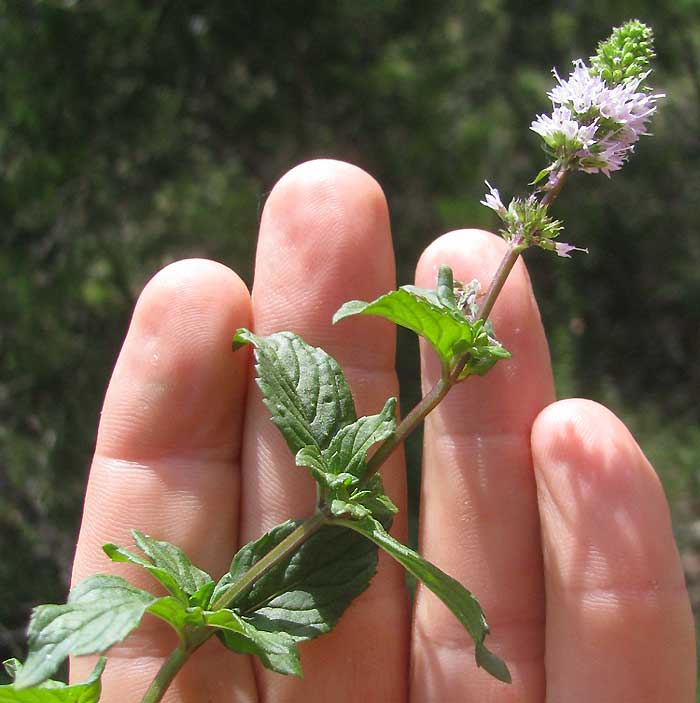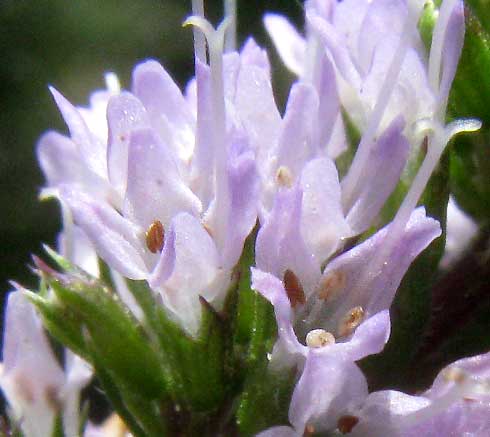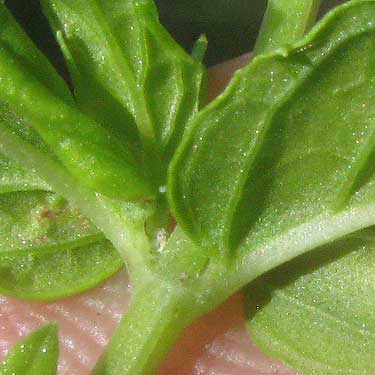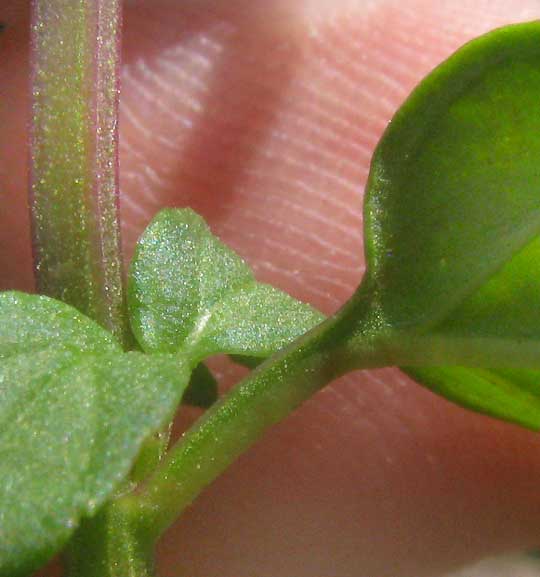Excerpts from Jim Conrad's
Naturalist Newsletter

from the August 4, 2013 Newsletter issued from the Frio Canyon Nature Education Center in the valley of the Dry Frio River in northern Uvalde County, southwestern Texas, on the southern border of the Edwards Plateau; elevation ~1750m (~5750 ft); N29.62°, W99.86°; USA
PEPPERMINT
Last winter on a gravel bar in the little Dry Frio River about three miles downstream, in a rather isolated spot, suddenly I smelled a wonderful mint odor, much sweeter and more subtle than that of the Spearmint commonly found in gardens. I'd stepped on a tiny, flowerless sprig of this unknown mint barely surviving in the gravel. What was it, and so far from any habitation, might it be a native mint? As we saw a couple of weeks ago when looking at Spearmint, there are lots of mints and unless you have flowers they can be hard to distinguish.
I carried the unknown mint sprig home and planted it in a pot. During the cold months it hardly grew at all, even as my pots of Spearmint grew like weeds. Eventually with warm weather the sprig came to life, and when hot weather arrived the sprig put on a surge of growth that had it catching up with the Spearmint. Also, almost overnight, leafy runners began growing horizontally from the plant's base, and these runners grew faster and were more substantial than those of Spearmint's stolons. All these observations didn't help me identify it, though, for what I needed were flowers.
Finally this week a single inflorescence appeared, and it's shown above. A close-up of some of its 5/32-inch-long (4mm) flowers appears below:

On the corolla in the picture's bottom right quarter you can see that the flowers are very slightly asymmetrical. The corolla lobe pointing to the picture's right is wider than the other three lobes, and it's indented at its tip, which the other lobes are not.
All this is like we saw two weeks ago with Spearmint's flowers, so already we know that the mystery mint is very closely related to Spearmint. In fact, the similarities are so profound that I began wondering whether it might be just a different-smelling Spearmint cultivar.
When I "did the botany," however, the gravel mint revealed itself as nothing less than Peppermint, MENTHA x PIPERITA.
That "x" in the name cues us that we're dealing with a hybrid, and that surprises me because in my old books Peppermint's binomial is given as Menta piperita without the x, meaning that the plant earlier was regarded as a full species. However, genetic sequencing now makes clear that Peppermint is a hybrid between Spearmint, Mentha spicata, native of Eurasia, and Water Mint, Mentha aquatica, native to northwest Africa and southwest Asia.
It's funny, but when you know you're dealing with the Peppermint plant, you can't imagine that earlier you didn't recognize the plant's fragrance as that of peppermint, for it smells exactly like the peppermint sticks of my childhood.
So, without resorting to the odor of its crushed leaves, how can you distinguish Spearmint from Peppermint? One easy way is this: Spearmint leaves have almost no petioles, while Peppermint leaves have very noticeable ones.
A Spearmint leaf base with no petiole is shown below:

The substantial petiole connecting the stem and leaf blade of a Peppermint is seen below:

Who knows how our Peppermint sprout came to find itself growing in gravel beside a river in such an isolated spot?
Peppermint oil has been highly regarded for a long time. On the Internet, websites copy from one another the statement that "archeological evidence places Peppermint's use at least as far back as ten thousand years ago," but no authorities are given. It is further asserted that Aristotle wrote of peppermint as an aphrodisiac, and Alexander the Great forbade his soldiers to have peppermint because he thought it promoted erotic thoughts, reducing his soldiers' desire for fighting.
Nowadays peppermint oil is used medicinally for nausea, indigestion, and the cold. Its high concentration of menthol is regarded as good for the skin and scalp, where it is thought to increase blood flow. It's antiseptic and antibacterial. It's the oldest and most popular flavoring for toothpaste and gum.